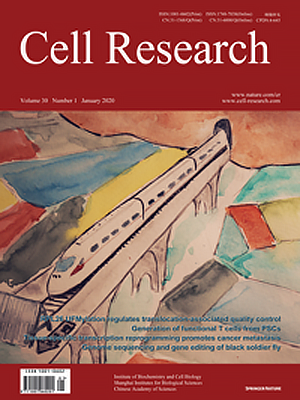
Volume 30, No 1, Jan 2020
ISSN: 1001-0602
EISSN: 1748-7838 2018
impact factor 17.848*
(Clarivate Analytics, 2019)
Volume 30 Issue 1, January 2020: 91-94
LETTERS TO THE EDITOR
Joint utilization of genetic analysis and semi-cloning technology reveals a digenic etiology of Müllerian anomalies
Lingbo Wang 1,2,3,4 , Ying Zhang 1,3, Xiaoyi Fu1,Shuangshuang Dong 1,3, Shuyan Tang 1,3,4, Ning Zhang 1,3,Chengcheng Song 1,3, Nan Yang 1,3, Lin Zhang2, Hongyan Wang 1,3,4,Huijuan Shi1, Li Jin1, Feng Zhang 1,3,4, Jinsong Li 2 and Keqin Hua 1,3
1Obstetrics and Gynecology Hospital, NHC Key Laboratory of Reproduction Regulation (Shanghai Institute of Planned Parenthood Research), State Key Laboratory of Genetic Engineering at School of Life Sciences, Fudan University, 200011 Shanghai, China; 2State Key Laboratory of Cell Biology, Shanghai Key Laboratory of Molecular Andrology, CAS Center for Excellence in Molecular Cell Science, Shanghai Institute of Biochemistry and Cell Biology, Chinese Academy of Sciences, University of Chinese Academy of Sciences, 200031 Shanghai, China; 3Shanghai Key Laboratory of Female Reproductive Endocrine-Related Diseases, Shanghai 200011, China and 4Institute of Metabolism and Integrative Biology, Fudan University, 200438 Shanghai, China
These authors contributed equally: Lingbo Wang, Ying Zhang, Xiaoyi Fu, Shuangshuang Dong
Correspondence: Feng Zhang (zhangfeng@fudan.edu.cn) orJinsong Li (jsli@sibcb.ac.cn) or Keqin Hua (huakeqin@fudan.edu.cn)
Dear Editor,
Identifying pathogenic gene mutations and their combination is critical but challenging in dissecting the etiology of complex diseases when more than one gene is involved.1 The digenic/oligogenic/omnigenic models, holding that more than one gene could act synergistically, appeal to a wide range of genes responsible for complex phenotypes.1,2,3,4 These genetic models advanced our understanding of genetic factors underlying complex phenotypes, yet an accordingly rapid and efficient experimental assay for identifying pathogenic combinations of genetic variants at animal model level is lacking and urgently needed.
https://doi.org/10.1038/s41422-019-0243-7
FULL TEXT | PDF
Browse 1032


